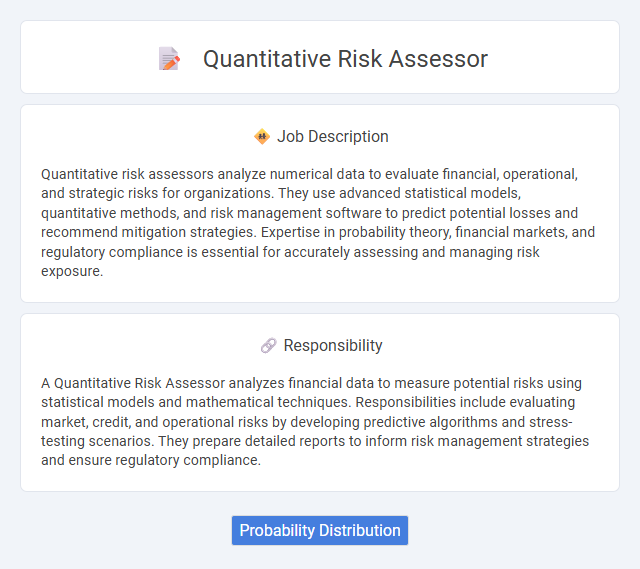
Quantitative risk assessors analyze numerical data to evaluate financial, operational, and strategic risks for organizations. They use advanced statistical models, quantitative methods, and risk management software to predict potential losses and recommend mitigation strategies. Expertise in probability theory, financial markets, and regulatory compliance is essential for accurately assessing and managing risk exposure.
Individuals with strong analytical skills and a keen attention to detail are likely to be well-suited for a quantitative risk assessor role, given the job's reliance on data analysis and risk modeling. Those comfortable working with complex statistical tools and able to manage high-pressure decision-making scenarios may find the position aligns with their capabilities. Conversely, people who struggle with numerical data or lack patience for repetitive tasks might face challenges adapting to this role.
Qualification
A Quantitative Risk Assessor typically requires a strong background in mathematics, statistics, or finance, often demonstrated by a bachelor's or master's degree in these fields. Proficiency in risk modeling software, data analysis tools like Python or R, and knowledge of regulatory standards such as Basel III or Solvency II is essential. Candidates with professional certifications such as FRM (Financial Risk Manager) or PRM (Professional Risk Manager) are highly valued for their expertise in assessing financial risks quantitatively.
Responsibility
A Quantitative Risk Assessor analyzes financial data to measure potential risks using statistical models and mathematical techniques. Responsibilities include evaluating market, credit, and operational risks by developing predictive algorithms and stress-testing scenarios. They prepare detailed reports to inform risk management strategies and ensure regulatory compliance.
Benefit
Quantitative risk assessor roles likely offer significant benefits through the ability to enhance decision-making by accurately analyzing potential financial and operational risks. Professionals in this position probably enjoy increased job security and competitive salaries due to the growing demand for data-driven risk management in various industries. The job may also provide opportunities for continuous learning and career advancement as organizations increasingly rely on quantitative analysis to mitigate uncertainties.
Challenge
Quantitative risk assessor roles likely demand strong analytical skills to interpret complex data and model potential uncertainties effectively. The challenge may involve accurately predicting financial or operational risks under dynamic market conditions while managing vast datasets. Probable pressure exists to deliver precise risk quantifications that inform critical decision-making processes within tight deadlines.
Career Advancement
A Quantitative Risk Assessor leverages statistical modeling and data analysis to evaluate financial, operational, and market risks, enabling informed decision-making in banking, insurance, and investment sectors. Expertise in programming languages like Python, R, and proficiency with risk management software amplifies career growth opportunities, leading to roles such as Senior Risk Analyst, Risk Manager, or Chief Risk Officer. Continuous professional development through certifications like FRM (Financial Risk Manager) or CFA (Chartered Financial Analyst) significantly accelerates advancement within risk management hierarchies.
Key Terms
Probability Distribution
A Quantitative Risk Assessor specializes in analyzing probability distributions to quantify uncertainties in financial, operational, or project-related risks. By applying statistical models such as normal, binomial, or Poisson distributions, they estimate the likelihood of various adverse events and their potential impacts. Mastery in probability distributions enables precise risk measurement and supports informed decision-making to mitigate potential losses.
 kuljobs.com
kuljobs.com